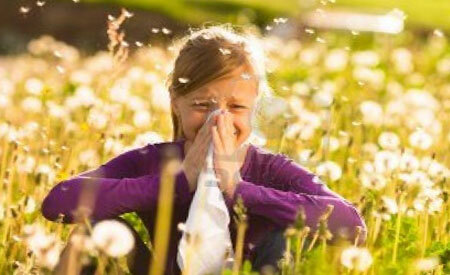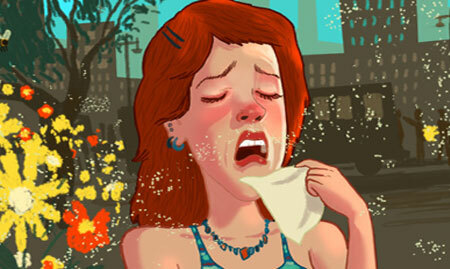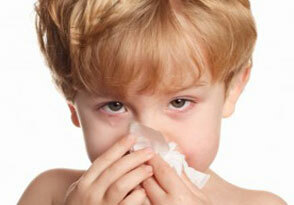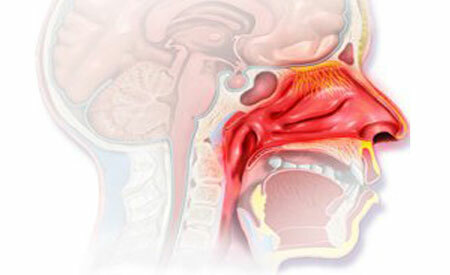With the problem of allergic rhinitis, an adult and a child can face at any age. Deteriorating environmental and living conditions, an abundance of air allergens lead to the fact that at a reception at a children's ENT doctor more and more small patients are found.
Consider what allergic rhinitis is and what methods of treatment are effective for children and adults.
Contents of
- 1 Allergic Rhinitis - What is it?
- 1.1 Causes
- 1.2 forms of allergic rhinitis in
- 2 children Symptoms of allergic rhinitis, photo
- 2.1 disease diagnosis
- 3 Treatment of allergic rhinitis in the child and adult
- 3.1 treatment in children
- 3.2 Specific immunotherapy( SIT)
- 4 prevention of allergic rhinitis
Allergic Rhinitis - What is it?

Manifestations of "hay fever" in children and adults, photo
Allergic rhinitis is a distorted reaction of the nasal mucosa to the effect of various external stimuli. The second name is "hay fever".
It used to be believed that the cause of the disease is hay and grass. It is now known that air allergens are much larger, and hay among them is almost the last place.
The disease is based on an inflammatory reaction that develops in response to the effects of certain allergens. Typically, the disease manifests itself in childhood, although there are cases of sudden onset of symptoms of allergic rhinitis in adults.
The reaction to the causative allergen develops rapidly. Already after 1-2 minutes after contact with it, the patient begins to lay his nose, watery eyes, etc.
In this case, the interaction of a person and an irritant substance should be interrupted as soon as possible. Prolonged and constant exacerbation of rhinitis in a child can lead to the development of chronic inflammatory processes in the nose.
Causes of

Various airborne allergens cause the problem. Before describing what they are, let's explain - for the development of allergic rhinitis, a child or adult should be sensitized to this allergen.
This means that a child's contact, for example, with poplar fluff will cause a severe attack of allergy, and the other will not happen.
When an allergy occurs, the immune system fails, which perceives certain substances as foreign and tries to cope with them through the reaction of an allergic inflammation. Why does this happen, no one knows for certain. Among the contributing factors, there are preterm, poor nutrition, heredity, the region of residence, etc.
The immediate cause of the allergic rhinitis is various substances, more often airborne spread:
- pollen of grasses and plants( ragweed, quinoa, wormwood, alder, etc.);
- excrement, wool, epidermis of pets;
- household chemicals;
- cosmetics;
- insects;
- fungi;
- home dust, which contains micro-pliers;
- plants and the substances released by them, odors;
In addition to airborne allergens, the cause of rhinitis can become food products( honey, nuts, seafood, etc.).In these cases, the symptoms of allergic rhinitis in a child are combined with gastrointestinal disorders and rashes on the skin.
Important! Separately identify the physical causes of allergies. So, the nasal mucosa can react to cold, heat and other climatic conditions( cold allergy).
Forms of allergic rhinitis in children
There is a division into seasonal( pollinosis) and year-round( permanent) forms of this disease.
Seasonal allergic rhinitis is associated with exposure to pollen from different plants. It repeats every year at the same time in the flowering period of this plant. Urban children are more susceptible to pollen from trees, while rural children are more susceptible to pollen of grasses and weeds.
The severity of an allergic reaction depends on the type of stimulus, the time it affects the body and the individual's sensitivity.
The year-round form appears with constant contact with the causative factor, for example, with dust containing mites. Active allergens are considered pets, fungi, mold, medicines and fodder for fish.
Symptoms of allergic rhinitis, photos

Pictures of symptoms of allergic rhinitis in a child
Symptoms and symptoms of allergic rhinitis in a child and adult are very similar. In most cases, the patient is concerned about:
- obstructed nasal breathing due to a nasal edema;
- is a transparent secretion, which when attached to a bacterial infection can change its color and consistency;
- sneezing attacks;
- the sense of smell is lost;
- lacrimation and eye irritation;
- photophobia and sensitivity to sunlight;
- congestion of the ears and hearing loss;
- on the background of permanently stuffed nose joins headache, fatigue, weakness, appetite decreases.
Some parents may underestimate rhinitis in a child and in vain. The allergic form of the disease often causes inflammation of the middle ear and the development of sinusitis( inflammation of the paranasal sinuses).

Prolonged absence of full nasal breathing seriously affects the normal physical and intellectual development of the child.
Diagnosis of the disease
For diagnosis, the doctor carefully collects an anamnesis and appoints a series of diagnostic tests. Indirectly, the presence of an allergic reaction may indicate an increase in eosinophils in a general blood test. However, this indicator can be increased in other diseases( helminthic invasion, etc.).
What special studies can confirm the presence of allergic rhinitis:
1. Skin tests. Perform a series of scratches with a special scarifier on the forearm, and then put on them an alleged allergen. The result is assessed by the presence or absence of a skin reaction. This method is not used during an exacerbation of allergies, as well as in young children.
Disadvantages: high probability of false results and at a time you can investigate no more than 7-10 allergens.
2. Determination of eosinophils in the smear from the nasal cavity .The essence of the method: during the exacerbation of rhinitis from the patient's nose, a smear is taken, if the inflammation is allergic, then a large number of eosinophils are found in the smear.
Disadvantages: apply only at the time of exacerbation, often gives false results.
3. Determination of the specific Jg-E. Determine its level in the blood, it is produced in response to the action of a specific allergen. This method has practically no contraindications.
Do not use in children until 6 months of age because of a weak immune response at this age.
4. Immunoblotting. This is a highly sensitive method that has no contraindications and gives a reliable result.
For analysis, take the patient's blood, which is applied to special paper. Specific proteins are shown on it with separate lines.
If the patient's blood has antigens to some protein, then a dark line appears in a certain area. There are 4 standard panels of allergens, allergic rhinitis in children is usually prescribed inhalation( home dust mites, birch pollen, alder, cat fur, dogs, etc.) or pediatric( pollen grass mixtures, egg whites, mites, etc.)the main allergens of these classes.
Treatment of allergic rhinitis in a child and adult

Treatment of allergic rhinitis in children and adults depends on the form and severity of the allergic reaction. The main components of effective treatment of allergic rhinitis are:
- Limitation or elimination of contact with a causative allergen.
- Antiallergic agents.
- SIT - specific immunotherapy.
- Physiotherapy( acupuncture, speleotherapy).
If necessary, surgical intervention is used if it is necessary to improve the aeration of the nasal cavity or clean the purulent focus. This happens when the allergy is combined with a curved nasal septum or chronic sinusitis.
Treatment in children
Let us consider in more detail medicines that are used for treatment in childhood:
1. Antihistamines. Used in the form of drops( Fenistil), in children after 10-12 years of the pill( Zodak, etc.).
2. Drops in the nose for allergic rhinitis are divided into several groups:
- Vasoconstrictive( Nazol-baby, etc.).Use once, in situations when you need to quickly remove the swelling. Do not apply for longer than 5-7 days and in children with a tendency to nosebleeds.
- Antihistamines( Vibrocil).Well suited for the treatment of seasonal forms. Act quickly and gently, apply for 2-3 weeks.
- Hormonal( Fliksonase, Nazonex).The main agent for the treatment of allergic rhinitis. They start to work after 5-6 days after the start of treatment, have a cumulative effect, do not show systemic action. Good allergic edema is removed and applied within 1-2 months.
- Moisturizing( Salin, Aqualor).Flush the allergen from the surface of the nasal mucosa and partially remove the swelling. Safe and can be used in children from the first days of life.
3. In severe cases, uses systemic hormones.
Specific immunotherapy( SIT)
 A little about SIT: This method is used when the causative allergen is accurately established.
A little about SIT: This method is used when the causative allergen is accurately established.
Patient step by step subcutaneously injected a small amount of substance-stimulus and, thus, teach the body to cope with the pathological response. Carry out courses in the period of remission.
If the child does not have a polyallergy or allergen, this method is not used.
Prevention of allergic rhinitis
Preventive measures include a set of measures to eliminate or restrict contact with the allergen:
- Do not go out during the flowering period of dangerous for the baby plants or change the geographical area at this time.
- Wet cleaned.
- Give relatives of pets.
- Special humidifiers and vacuum cleaners with HEPA filters are used.
- After the street take a shower and change the laundry.
- Regularly rinse the nose with mineral water without gas.
If an allergic reaction has been triggered, it is very difficult to get rid of it. The patient can take measures so that allergic rhinitis does not discomfort him and does not change the habitual way of life.
This can be done with the help of reasonable restrictions, as well as medicines and procedures that the doctor will choose.



